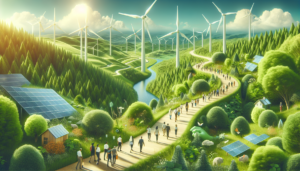Embracing the Green Transition: A Pathway to a Sustainable Future
In recent years, the term “green transition” has emerged as a focal point in discussions surrounding sustainability and climate change. As the world grapples with the consequences of global warming, the need for actionable solutions has never been more urgent. The green transition not only pertains to the shift from fossil fuels to renewable energy sources but also encompasses a broader range of societal changes aimed at achieving sustainability. This article delves into the key components of the green transition, its importance, and the steps we can take toward a more sustainable future.

Understanding the Green Transition
What is the Green Transition?
The green transition refers to the process of transforming our economies and societies to be more environmentally sustainable. This involves reducing carbon emissions, promoting renewable energy, and enhancing energy efficiency. According to the Intergovernmental Panel on Climate Change (IPCC), without significant changes to our current practices, global temperatures could rise dramatically, posing severe risks to ecosystems and human life.
Key Components of the Green Transition
- Renewable Energy Adoption: Transitioning from fossil fuels to renewable energy sources such as solar, wind, and hydroelectric power is crucial. For instance, solar energy has seen a rapid growth of over 20% per year in installations globally, driven by decreasing costs and technological advancements.
- Energy Efficiency Improvements: Enhancing energy efficiency in industries, homes, and transportation systems not only reduces energy consumption but also cuts costs. According to the U.S. Department of Energy, improving energy efficiency has the potential to reduce energy usage in buildings by up to 30%.
- Sustainable Agriculture: Green transition also focuses on revising agricultural practices to minimize environmental impact. Utilizing organic farming techniques and regenerative agriculture can significantly reduce carbon footprints while enhancing food security.
- Circular Economy Models: Moving away from a linear economy of “take-make-dispose” towards a circular economy where resources are reused and recycled is vital. The Ellen MacArthur Foundation estimates that adopting circular economy principles could reduce global greenhouse gas emissions by 39% by 2030.
- Green Transportation: Embracing electric and public transportation, along with promoting walkable cities, helps mitigate urban pollution and carbon emissions. Countries like Norway and Sweden are leading the way in electric vehicle (EV) adoption, with a significant percentage of new car registrations being electric.

Why the Green Transition Matters
The significance of the green transition cannot be overstated. Here are a few reasons why it is essential for our future:
Climate Change Mitigation
The green transition is pivotal in combating climate change. According to the United Nations, we must limit global warming to 1.5 degrees Celsius above pre-industrial levels to prevent catastrophic impacts on our planet. Shifting to renewable energy and sustainable practices is a fundamental step in achieving this goal.
Economic Opportunities
Investing in green technologies and practices presents vast potential for job creation. The International Renewable Energy Agency (IRENA) reports that renewable energy sectors employed 11.5 million people globally in 2018, with substantial growth expected. Transitioning to a sustainable economy opens numerous avenues for innovation and entrepreneurship.
Enhanced Public Health
By reducing air and water pollution, the green transition can significantly enhance public health. The World Health Organization (WHO) states that air pollution kills approximately 7 million people each year. Prioritizing clean energy and sustainable practices can lead to healthier communities.
The Role of Individuals and Communities
While the responsibility for the green transition lies with governments and industries, individuals and communities can play a crucial role as well.
1. Educate Yourself
Understanding the principles and importance of the green transition can empower individuals to make informed choices in their personal and professional lives. Knowledge about sustainable practices encourages activism and community involvement.
2. Reduce Your Carbon Footprint
Simple actions such as using public transportation, reducing water usage, and choosing energy-efficient appliances can collectively make a significant impact. Embracing a minimalist lifestyle also promotes sustainability.
3. Support Sustainable Brands
Choosing to support businesses that prioritize sustainability creates demand for green products and practices. Research companies that commit to environmentally friendly practices and support them.
4. Advocate for Change
Participate in local initiatives, support legislation that promotes green practices, and advocate for policies that push for the green transition within your community.
Conclusion: A Collective Effort Towards a Sustainable Future
The green transition is not just a trend; it is a necessity for the survival of our planet and future generations. By embracing renewable energy, improving efficiency, and adopting sustainable practices, we can pave the way toward a more sustainable and resilient future. While challenges remain, the benefits of the green transition far outweigh the obstacles. Together, we can contribute to a more sustainable world for ourselves and generations to come.
Tags:
#GreenTransition #Sustainability #RenewableEnergy #ClimateChange #EcoFriendly
Categories:
Sustainability, Renewable Energy, Environmental Science, Green Living
Call to Action:
Join the green transition movement today! Share your sustainable practices in the comments below and let’s inspire each other to make a lasting change.



